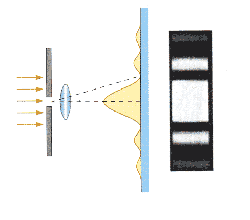

Very far from a point source the wave fronts are essentially plane

Where crest meets trough we have destructive interference. Where crest meets crest we have constructive interference and All these waves interfere to produce the diffraction pattern. Huygens' principle tells us that each part of the slit can be thought of as anĮmitter of waves. Screen that is a distance L > w away from the slit. When light passes through a single slit whose width w is on the order of the wavelength of the light, then we can observe a single slit diffraction pattern on a Water waves in a ripple tank A single large slitĪnd Diffraction - Exploring Wave Motion (YouTube) Is a wave phenomenon and is also observed with water waves in a ripple tank. The light spreads around the edges of the obstacle. The other side of the opening resembles the wave front shown on the right. Wavelength λ of the light, in an otherwise opaque obstacle, the wave front on When light passes through a small opening, comparable in size to the Replace any wave front by a collection of sources distributed uniformly over the When studying the propagation of light, we can Huygens' principle also holdsįor electromagnetic waves. With each other to produce the traveling wave. The wavelets emitted by all points on the wave front These wavelets propagate outward with the characteristic Lets us treat wave propagation by considering every point on a wave front to be a secondary source of Diffraction results from the interference of an infinite number of wavesĮmitted by a continuous distribution of source points in two or three dimensions. Passing through a finite aperture to spread out as it propagates. (We already encountered interference when studyingĭiffraction is the tendency of a wave emitted from a finite source or Mathematical treatment is much more involved.ĭiffraction and interference are phenomena observed with all waves.ĭiffraction can only be observed with waves traveling in two or threeĭimensions. Wave optics contains all of ray optics, but the If the wavelengths of the light become comparable to the dimensions of theĮquipment, then we study optical phenomena using the classical theory of radiation, or wave optics. So, as far as visible light is concerned, matter is quasi-continuous. Individual atoms in a solid are separated by distance on the order of 0.1 nm. So a laser beam with a diameter of 1 mm has a diameter of 2000 wavelengths. Wavelengths in the middle of the visible band are on the order of 500 nm. Consider the wavelength scale of light waves. Under these conditions we can make an approximation called In many situations, the wavelengths of the light being studied are very smallĬompared to the dimensions of the equipment used to study the light. Light is a transverse electromagnetic wave. In classical physics, we can classify optical phenomena into one of two categories: ray optics and wave optics. Single slit diffraction Single slit diffraction


 0 kommentar(er)
0 kommentar(er)
